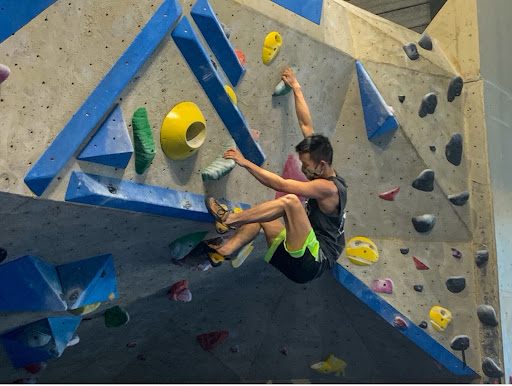
Located at the back of a small shopping centre, Coyote Rock Gym in Ottawa South dons a mysterious exterior. Delivery trucks scattered across the parking lot perpetuate the illusion that it’s nothing more than a warehouse. A small sign, often obscured by snow in the winter, states the name of the gym above the dark metal doors and is the only indication of what lies inside.
Beyond the cold exterior and inside the gym, a sea of colour overwhelms by contrast. A rainbow of small stones and boulders covers the walls. People of all ages crowd the space. Their encouraging hoots and hollers echo off the walls as they cheer on fellow climbers.
In the corner of the gym, among the bustle of other climbers, sits Kai Houston. Houston, a fourth year biomedical and mechanical engineering student at Carleton University, has been climbing since 2014 and is currently co-president of the Carleton Climbing Club.
He secures the straps of his mustard-yellow climbing shoes and moves through a series of stretches in a nearly robotic rhythm. Once warmed up, the 21-year-old decides which path of stones to follow up the wall and begins his first climb of the evening.
With all restrictions and mask mandates now lifted in the gym, there is little to suggest that the past two years have been filled with pandemic-induced challenges.
Despite a returning sense of normalcy, Houston does not easily forget the impacts of the COVID-19 pandemic, having spent months unable to climb due to gym closures. Coyote Rock Gym first closed in 2020 due to the pandemic, opening and closing multiple times since then as government restrictions changed.
“I’ve taken a huge hit from COVID because it’s just a lot harder to get yourself to the gym after not going for so long,” Houston said.
Houston is one of many athletes across Canada who have struggled with their mental health during these isolating times.
Since March 2020, sports organizations have struggled to operate normally due to constantly changing government health regulations. The rising and falling of COVID-19 case counts created an unreliable training environment as sports programs bounced between being open, closed or open with modified regulations.
For countless athletes, their entire lives are shaped around their sport. The sudden inability to train left many feeling as though the rest of their lives were falling apart. Houston said cutting out training impacts both the physical and mental components of an athlete’s life.
“You lose the social aspect, you lose that rush you get from training, everything takes more effort … even getting out of bed, getting up, sitting down—it’s all harder,” he said.

Olympic dreams shattered
Houston’s reality is an unfortunate one shared by many athletes during the pandemic.
For 21-year-old Catherine Barrett, 2020 began with plans of travelling to the Tokyo Olympics to represent Team Canada. However, by March 2021, the artistic swimmer had retired from the national team, leaving her Olympic dreams behind.
Having joined the national artistic swimming team at the age of 18, Barrett helped the team secure a spot for the 2020 Olympics and was mere months away from heading to Tokyo when the pandemic hit. To prepare, she had been training between 45 to 50 hours a week in Montreal at the Institut National du Sport du Québec (INS).
“My whole life was completely absorbed around being at the pool,” she said.
When initial lockdowns were implemented, Barrett remained positive, doing her best to train at home in St. John’s, N.L. Not having access to a pool, however, led her to fear her training was not nearly as effective. From March 2020 to July 2020, Barrett trained on-land only.
“That was the longest time in my entire life that I hadn’t been in a swimming pool,” she said.
In March 2020, the International Olympic Committee and the Tokyo 2020 Organising Committee released a joint statement announcing the games would be postponed. Barrett continued to train virtually with her team, but losing in-person training took its toll on her.
“It was depressing. I fell into a really heavy cycle of sleep until 10 minutes before the first workout and then [slept] until 10 minutes before the next workout,” she said. “It was unhealthy.”
Barrett said she felt “fairly numb” to the whole experience.
Even after returning to Montreal to train in-person, Barrett struggled. While many factors led to her ultimately leaving the national team, Barrett says the pandemic played a significant role.
“A big part that really broke me down and [meant] I couldn’t continue anymore was the isolation,” she said.
On March 29, 2021, Barrett took to Instagram to announce her retirement publicly. She wrote, “I have been candid on my social media, and with my teammates, coaches, staff, friends, and family in real life about my mental illness struggles over the past decade, and I have come to the decision that where I need to be is at home with my family.”
Uncertainty breeds anxiety
Barrett is just one example of the numerous athletes struggling with their mental health on top of the physical demands of training.
A 2021 study showed that 41.4 per cent of Canadian national team athletes who were training for the 2020 Summer Olympic Games met the cut-off criteria for one or more mental disorders including anxiety, depression and eating disorders. For comparison, the study states approximately only ten per cent of Canadians report a mental disorder in a given 12-month period.
While this study was conducted pre-pandemic, the scope of the pandemic only worsened these mental disorders already being dealt with by athletes. According to Dr. Michel Larivière, clinical psychologist and professor at Laurentian University, the uncertainty of when sports will return causes anxiety for many athletes.
“In a chronic state of unknowing, unfamiliarity and uncertainty about the future, people get uneasy and they tend to ruminate more,” he said. “[They] worry about a whole bunch of things that they otherwise wouldn’t be worrying about.”
Larivière also noted athletes practicing individual sports are likely to lack the same support other athletes gained from their teammates during the pandemic.
The false starts struggle
Jean-Philippe Tourigny, a goalie for the University of Ottawa men’s hockey team, is another athlete who experienced a decline in mental well-being due to the pandemic and its isolation.
Tourigny has been surrounded by hockey his entire life. Growing up as the son of NHL coach André Tourigny, every part of his life revolved around hockey. He has been playing since he was a child.

“It was definitely tough; I had to learn to spend my time differently,” he said.
Like many athletes, the persistent stops and starts of training caused by COVID-19 shutdowns made it difficult for Tourigny to gain control of his physical and mental wellbeing.
“Personally, I struggle with finding a good routine, and because everything would change month to month, I was never really able to narrow that down,” he said. “That caused me to be more sluggish and depressed.”
Mental wellness beyond the pandemic
While a return to pre-pandemic routines could be in sight, it’s unclear when Canadian athletes will be able to fully resume their training without any lingering restrictions. Larivière said he believes the pandemic-related anxieties and fear felt by athletes will likely continue long after the pandemic is over.
“There’s going to be this ongoing sense of regret, disappointment and unfinished business [among athletes who] just weren’t able to … showcase their highest peak or be there when it really mattered,” he said.
Athletes can find resources to aid with pandemic-related mental health through the Game Plan and Canadian Centre for Mental Health and Sport websites.
Featured image by Jenna Legge.





